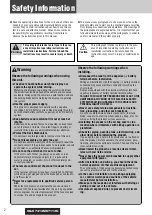
-38-
GND connection terminal. (Digital ground terminal).
External X’tal and capacitor for internal sync generator, or the external clock are connected to
this terminal. (2fsc or 4fsc).
Either the external clock input mode or the X’tal generator mode is selected by this selector
terminal. L: X’tal generator mode, H: External clock input.
Blank signal (character and the green ORed signal) is output from this terminal.
(MODE 0: composite sync signal is output at H.) When reset (RST terminal = L), the X’tal
External coil and capacitor for the character output dot clock generator are connected to this
terminal.
The character signal is output from this terminal. (MOD 0: when H, the external sync signal
identification signal is output from this terminal. This output signal tells whether the external
sync signal is present or not. When external sync signal is present, H is output.) When reset
(RST terminal = L), the dot clock signal (LC oscillator) is output.
(It is not output when reset by the reset command).
Enable signal for the serial data input is input to this terminal. The serial data input is enabled
at L. Pull-up resistor is built-in. (Hysteresis input).
Clock of the serial data input is input to this terminal. Pull-up resistor is built-in.
(Hysteresis input).
Serial data input terminal. Pull-up resistor is built-in. (Hysteresis input).
Power supply for the composite video signal level adjustment. (Analog power supply).
Composite video signal output terminal.
Connected to GND or not connected.
Composite video signal input terminal.
Power supply (+5V digital power supply).
Video signal for the internal sync separator circuit is input to this terminal. (When the internal
sync separator circuit is not used, the horizontal sync signal or composite sync signal is input
to this terminal).
Internal sync separator circuit bias voltage monitoring terminal.
The composite sync output signal of the internal sync separator circuit is output from this
terminal. (H: MOD 1. H: during internal sync mode. L: during external sync mode.)
(When internal sync separator circuit is not used, the SYN IN input signal is output from
this terminal).
The output signal of the SEP OUT terminal is integrated so that the vertical sync signal is input
to this terminal. An integrator circuit must be connected between the SEP OUT terminal and
this terminal. When this terminal is not used, it must be connectedto VDD1.
When selecting any of the NTSC or PAL or PAL-M or PAL-N system, the pin setting has
priority. When L, the NTSC system is selected after resetting. Selection of either NTSC or PAL
or PAL-M or PAL-N system by the command becomes effective. H: PAL-M system.
VSS1
Xtal IN
Xtal OUT
CTRL1
BLANK
OSC IN
OSC OUT
CHARA
CS
SCLK
SIN
VDD2
CV OUT
NC
CV IN
VDD1
SYN IN
SEP C
SEP OUT
SEP IN
CTRL2
1
2
3
4
5
6
7
8
9
10
11
12
13
14
15
16
17
18
19
20
21
—
I
O
I
O
I
O
O
I
I
I
—
O
—
I
—
I
—
O
I
I
Pin No.
Pin Name
I/O
Description
clock signal is output. (It is not output when reset by the reset command).
22
CTRL3
I
Controls whether or not to input the VSYNC signal to the SEPIN input. L: to input the
VSYNC signal. H: not to input the VSYNC signal.
IC, LC74781M-9017
Содержание RC-AAT20
Страница 22: ...WIRING 5 CD C B 22 ...
Страница 46: ... 46 LCD DISPLAY FL 9 ST 19GONK GRID ASSIGNMENT AND ANODE CONNECTION GRID ASSIGNMENT ...
Страница 47: ... 47 ANODE CONNECTION ...
Страница 48: ... 48 ...
Страница 56: ...2 11 IKENOHATA 1 CHOME TAITO KU TOKYO 110 8710 JAPAN TEL 03 3827 3111 737004 Printed inSingapore ...
















































